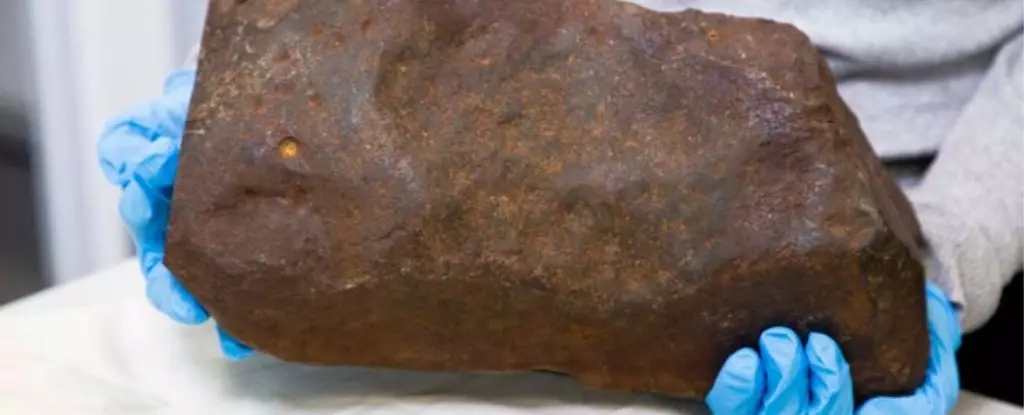In 2015, in the serene landscapes of Maryborough Regional Park, Australia, an ordinary day of prospecting would soon turn extraordinary. David Hole, equipped with his keen sense of discovery and a metal detector, unearthed a peculiar find—an unusually heavy, reddish rock embedded within yellow clay. His instincts ignited, as tales of the prosperous gold rush era surged through his mind. The Goldfields region, known for its glimmering past, set the stage for what he believed could be a glorious gold nugget.
The Struggle to Reveal Nature’s Secret
Driven by the tantalizing prospect of hidden riches, Hole devoted considerable time and energy to liberating the supposed nugget. Armed with an arsenal of tools, ranging from rock saws to acids, he was determined to crack the enigma encased within the rock. However, despite his fervent attempts, from angle grinders to sledgehammers, the rock stubbornly remained intact. As fate would have it, Hole’s persistence gave way to a revelation he could never have anticipated: the rock was not a precious nugget, but rather a rare meteorite.
Melbourne Museum geologist Dermot Henry provided insight into the uniqueness of this find. “What gave it away were the distinctive sculpted patterns,” he noted. These features are caused by meteoric objects burning and melting upon their fiery entry through Earth’s atmosphere, resulting in their unique textures.
Intrigued and unable to unlock the mysteries of his discovery on his own, Hole decided to have the rock examined at the Melbourne Museum. Henry, with 37 years of experience, was well-acquainted with the skepticism required when evaluating rock specimens. Identifying a meteorite is no trivial matter; only two rocks in his extensive career had proven to be authentic meteorites. However, this time, luck was on Hole’s side. The discovery was indeed a meteorite, later named the Maryborough meteorite in honor of its origin.
Weighing an impressive 17 kilograms (37.5 pounds), its composition revealed an extraordinary high percentage of iron, classifying it as an H5 ordinary chondrite. Researchers employed a diamond saw to slice into the seemingly mundane rock, unveiling crystalline structures, known as chondrules, that emanated from the very cosmos.
A Glimpse into the Cosmos
Meteorites are not merely exotic rocks; they bring with them a wealth of information about the universe’s origins. As Henry pointed out, they serve as the most cost-effective form of space exploration available. Each meteorite tells the story of the solar system’s formation and the elemental building blocks that contributed to the creation of Earth as we know it. “In many, you find remnants of stardust that precede even our solar system, offering insights into the birth and life cycles of stars,” he explained. Furthermore, some rare specimens contain organic molecules, hinting at the biological potential that exists beyond Earth.
Despite being subjected to earthly elements for possibly 100 to 1,000 years, the origins of the Maryborough meteorite remain somewhat elusive. Researchers speculate that it likely originated in the asteroid belt positioned between Mars and Jupiter, theorizing that a collision nudged it from its native orbit into the path of Earth. Historical meteor sightings recorded between 1889 and 1951 may correlate to its fateful arrival.
The Maryborough meteorite’s significance extends beyond its scientific validity; it possesses an extraordinary rarity compared to traditional gold finds. As Henry elucidated, only 17 meteorites have ever been documented in the Australian state of Victoria, making this specimen particularly invaluable for research. This meteorite stands as the second largest chondritic mass ever located, surpassed only by a 55-kilogram specimen identified years prior.
The contrast in discovery frequency is staggering; while thousands of gold nuggets have been unearthed in Victoria, the rarity of meteorites culminates in an astronomical chance of finding one. The discovery of the Maryborough meteorite epitomizes a remarkable intersection between curiosity, perseverance, and the pursuit of knowledge.
A Call to Explore
As the story of David Hole illustrates, sometimes treasures lie hidden in plain sight, waiting for those with curiosity and determination to uncover them. The chance of stumbling upon cosmic remnants might just compel amateur prospectors and hobbyists to inspect their own backyards for similarly heavy rocks. Who knows? You might just discover a piece of the universe resting beneath your feet.

